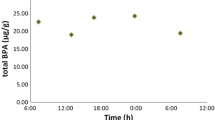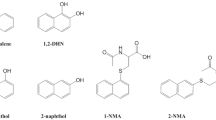Abstract
Objectives: The exposure of seven workers and three on-site study examiners to N-methyl-2-pyrrolidone (NMP) was studied in an adhesive bonding compound and glue production facility. Methods: Airborne NMP was analysed by personal and stationary sampling on activated charcoal tubes. NMP and its main metabolites, 5-hydroxy-N-methyl-2-pyrrolidone (5-HNMP) and 2-hydroxy-N-methylsuccinimide (2-HMSI), were analysed in pre-shift and post-shift spot urine samples by gas chromatography-mass spectrometry. The workers were examined with respect to irritation of the eyes, the mucous membranes and the skin, and health complaints before and after the work-shift were recorded. Results: The time-weighted average concentration of NMP in most work areas varied between 0.2 and 3.0 mg/m3. During the manual cleaning of stirring vessels, valves and tools, 8-h TWA exposures of up to 15.5 mg/m3 and single peak exposures of up to 85 mg/m3 were observed. NMP and its metabolites were detected in two pre-shift urine specimens. NMP and 5-HNMP concentrations in post-shift urine samples of five workers and three on-site study examiners were below 125 μg/g creatinine and 15 mg/g creatinine, respectively, while two vessel-cleaning workers showed significantly higher urinary NMP concentrations of 472 and 711 μg/g creatinine and 5-HNMP concentrations of 33.5 and 124 mg/g creatinine. 2-HMSI was detectable in four post-shift samples (range: 1.6–14.7 mg/g creatinine). The vessel cleaner with the highest NMP exposure reported irritation of the eyes, the upper respiratory tract and headaches. Conclusions: The results of this study indicate a relatively low overall exposure to NMP in the facility. An increased uptake of NMP occurred only during extensive manual vessel cleaning. Health complaints associated with NMP exposure were recorded in one case and might be related to an excessive dermal exposure due to infrequent and inadequate use of personal protective equipment.



Similar content being viewed by others
References
Åkesson B (2001) N-Methyl-2-pyrrolidone. Concise international chemical assessment document 35, International Programme on Chemical Safety, World Health Organization, Geneva, http://www.inchem.org/documents/cicads/cicads/cicad35.htm
Åkesson B, Jönsson BAG (1997) Major metabolic pathway for N-methyl-2-pyrrolidone in humans. Drug Metab Dispos 25:267–269
Åkesson B, Jönsson BAG (2000) Biological monitoring of N-methyl-2-pyrrolidone using 5-hydroxy-N-methyl-2-pyrrolidone in plasma and urine as the biomarker. Scand J Work Environ Health 26:213–218
Åkesson B, Paulsson K (1997) Experimental exposure of male volunteers to N-methyl-2-pyrrolidone (NMP): acute effects and pharmacokinetics of NMP in plasma and urine. Occup Environ Med 54:236–240
Anundi H, Lind ML, Friis L, Itkes N, Langworth S, Edling C (1993) High exposures to organic solvents among graffiti removers. Int Arch Occup Environ Health 65: 247–251
Anundi H, Langworth S, Johanson G, Lind ML, Åkesson B, Friis L, Itkes N, Söderman E, Jönsson BAG, Edling C (2000) Air and biological monitoring of solvent exposure during graffiti removal. Int Arch Occup Environ Health 73:561–569
Bader M, Keener SA, Wrbitzky R (2005) Dermal absorption and urinary elimination of N-methyl-2-pyrrolidone. Int Arch Occup Environ Health 8 (in press)
Bader M, Will W, Rossbacher R, Nasterlack M, Wrbitzky R (2002) N-Methyl-2-pyrrolidon—Arbeitsmedizinische Bedeutung und Toxikologie. Arbeitsmed, Sozialmed, Umweltmed 9:422–428
Beaulieu HJ, Schmerber KR (1991) M-Pyrol™ (NMP) use in the microelectronics industry. Appl Occup Environ Hyg 6:874–880
DIN EN 482 (2005) Workplace atmospheres—general requirements for the performance of procedures for the measurement of chemical agents. Beuth Verlag, Berlin, Wien, Zürich
Greim D, Lehnert G (eds) (1994) N-Methyl-2-pyrrolidon (Dampf). Maximale Arbeitsplatzkonzentrationen. Arbeitsmedizinisch-toxikologische Begründungen. Senatskommission zur Prüfung gesundheitsschädlicher Arbeitsstoffe. Deutsche Forschungsgemeinschaft. 20. Lieferung, Wiley-VCH, Weinheim
HSE (Health and Safety Executive): N-Methyl-2-pyrrolidone. Risk assessment document. EH72/10, ISBN 0717615286, HSE Books, Sudbury, UK, 1997
Jönsson BAG, Åkesson B (1997) Determination of 5-hydroxy-N-methyl-2-pyrrolidone and 2-hydroxy-N-methylsuccinimide in human urine. J Chromatogr B 694:351–357
Jungbauer FHW, Coenraads PJ, Kardaun SH (2001) Toxic hygroscopic contact reaction to N-methyl-2-pyrrolidone. Contact Derm 45:303–304
Langworth S, Anundi H, Friis L, Johanson G, Lind ML, Söderman E, Åkesson B (2001) Acute health effects common during graffiti removal. Int Arch Occup Environ Health 74:213–218
Leira HL, Tiltnes A, Svendsen K, Vetlesen L (1992) Irritant cutaneous reactions to N-methyl-2-pyrrolidone (NMP). Contact Derm 27:148–150
Saillenfait AM, Gallissot F, Langonne I, Sabate JP (2002) Developmental toxicity of N-methyl-2-pyrrolidone administered orally to rats. Food Chem Toxicol 40:1705–1712
Saillenfait AM, Gallissot F, Morel G (2003) Developmental toxicity of N-methyl-2-pyrrolidone in rats following inhalation exposure. Food Chem Toxicol 41:583–588
Xiaofei E, Wada Y, Nozaki JI, Miyauchi H, Tanaka S, Seki Y, Koizumi A (2000) A linear pharmakokinetic model predicts usefulness of N-methyl-2-pyrrolidone (NMP) in plasma or urine as a biomarker for biological monitoring for NMP exposure. J Occup Health 42:321–327
Acknowledgement
The authors wish to thank the employees of Forbo-Helmitin, Pirmasens, Germany, for their participation in the study and gratefully acknowledge the support from the company.
Author information
Authors and Affiliations
Corresponding author
Rights and permissions
About this article
Cite this article
Bader, M., Rosenberger, W., Rebe, T. et al. Ambient monitoring and biomonitoring of workers exposed to N-methyl-2-pyrrolidone in an industrial facility. Int Arch Occup Environ Health 79, 357–364 (2006). https://doi.org/10.1007/s00420-005-0065-4
Received:
Accepted:
Published:
Issue Date:
DOI: https://doi.org/10.1007/s00420-005-0065-4




